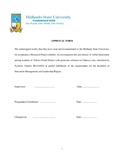Please use this identifier to cite or link to this item:
https://cris.library.msu.ac.zw//handle/11408/2729Full metadata record
| DC Field | Value | Language |
|---|---|---|
| dc.contributor.author | Nyokoto, Charles | - |
| dc.date.accessioned | 2017-07-28T10:13:04Z | - |
| dc.date.available | 2017-07-28T10:13:04Z | - |
| dc.date.issued | 2016 | - |
| dc.identifier.uri | http://hdl.handle.net/11408/2729 | - |
| dc.description.abstract | This study was carried out to explore the prevalence of verbal harassment among students of Gokwe North District with particular reference to Chireya zone. The researcher used a descriptive survey design in this research. The research was based on a sample of twenty-four student who participated in a focus group discussion, thirty-five teachers who answered questionnaires and from these thirty-five teachers, eight class teachers responded to an interview and these participants were drawn from four randomly selected rural day secondary schools in Gokwe North’s Chireya zone. All the participants were selected using the simple random and stratified random sampling. The main findings of the study were that verbal harassment is prevalent among students of Gokwe North Chireya zone. The study revealed different forms of verbal harassment whose perpetrators students themselves and teachers, and these are scolding, threatening, name calling, making nasty comments, whistling, spreading malicious runours and discriminating comments. It was also concluded from the findings that the contributory factors to verbal harassment in the area studied were family background, poverty, gender gap, lack of adequate resources, disability, lack of guidance and counseling, identity crisis, culture differences, spreading of malicious rumous, jealousy and ignorance. It was also concluded in the study that verbal harassment made victims feel uncomfortable, humiliated, unloved, offended, disappointed, angry, harsh, can head to hatrage for life, leads to school absenteeism, affects class participation, concentrations, performance, increase dropout and children lost trust in the teacher. Basing on the findings, the study recommended schools to be conducive and friendly enough so that information regarding verbal harassment is reported to them, put in place systems that will protect learners who report cases of verbal harassment and, purchase sufficient furniture for the students. Schools should have a set of rules and regulations that guide all actions, and schools should take guidance and counseling as a subject seriously. | en_US |
| dc.language.iso | en | en_US |
| dc.publisher | Midlands State University | en_US |
| dc.subject | Verbal harassment | en_US |
| dc.title | An investigation into prevalence of verbal harassment among students of Gokwe North District with particular reference to Chireya zone | en_US |
| item.fulltext | With Fulltext | - |
| item.grantfulltext | open | - |
| item.languageiso639-1 | en | - |
| Appears in Collections: | Bachelor of Educational Management and Leadership Degree. | |
Files in This Item:
| File | Description | Size | Format | |
|---|---|---|---|---|
| Dissertation Final - Nyokoto.pdf | Full Text | 1.02 MB | Adobe PDF |  View/Open |
Page view(s)
238
checked on Dec 30, 2025
Download(s)
604
checked on Dec 30, 2025
Google ScholarTM
Check
Items in MSUIR are protected by copyright, with all rights reserved, unless otherwise indicated.



